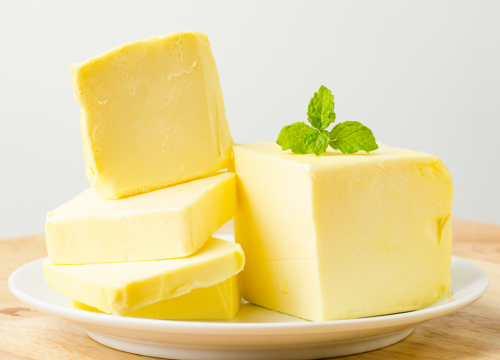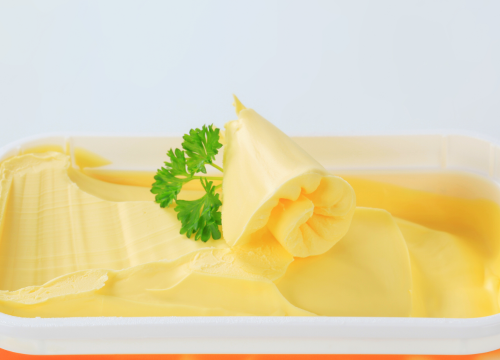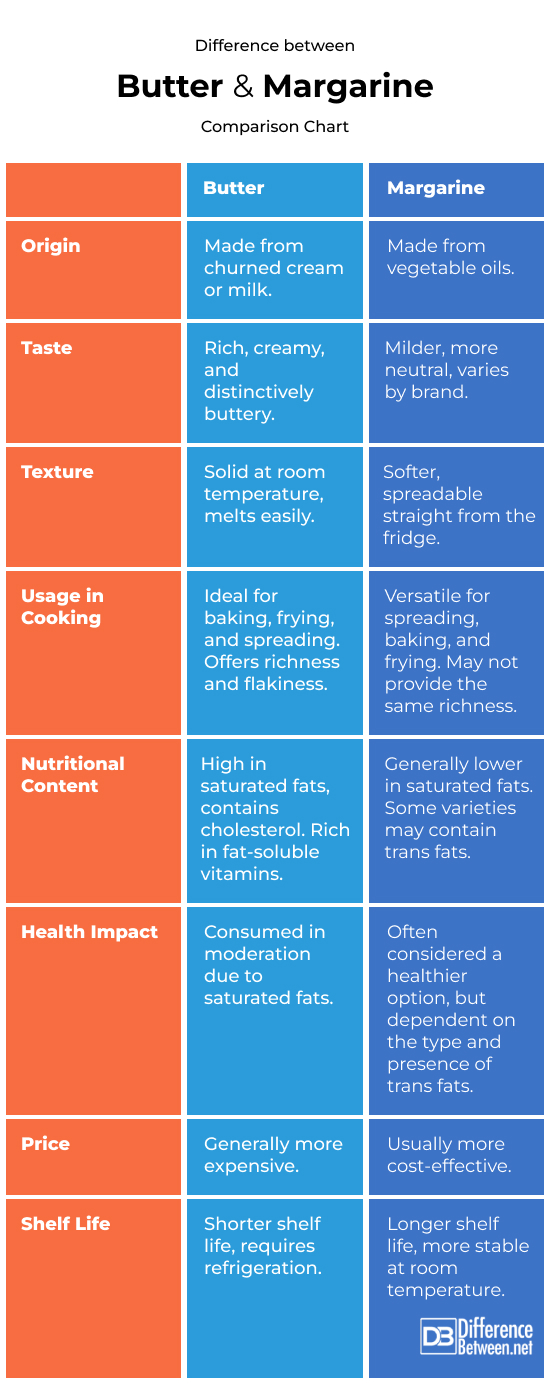Difference Between Butter and Margarine
Have you ever pondered, “Butter or margarine, which one’s better for my toast—and my health?” while perusing the grocery store? You are not alone. This enduring culinary quandary extends beyond just two spreads, impacting considerations of health, cookery, and the environment.
Consider this: both sit on the store shelf, appearing deceptively similar. Closer examination reveals that they are as dissimilar as chalk and cheese (or butter and margarine?). There’s much to deliberate, from their production methods to their composition, and how they interact in your favorite cookie recipe.
The choice between butter and margarine transcends mere flavor preferences. Understanding the substances we consume is vital. Let’s navigate through this buttery conundrum. By the end, you might reassess your next spread.

What is Butter?
For decades, butter, a cherished smooth spread, has enhanced the flavors of meals. What is it, precisely? Butter is crafted by churning milk or cream, a process that magically transforms a liquid into butter.
Butter has played a pivotal role in various cultural cuisines since ancient times. While each society may add its unique twist, the fundamental idea remains constant: converting milk fat into a delectable spread.
Characteristics
Butter not only delights the taste buds but also gracefully melts in the mouth. Its flavor is a harmonious blend of smoothness and a subtle sweetness, elevating even the simplest bread. In terms of texture, it strikes a balance between softness and firmness, resembling creamy bliss that melts seamlessly when encountering warmth.
Butter is an unsung hero in the kitchen. Whether sautéing vegetables, crafting flaky pastries, or generously applying it to pancakes, butter imparts a distinctive taste. It is the secret ingredient that turns a mere grilled cheese sandwich into a golden masterpiece.
Nutritional Profile
Concerned about the high fat content in butter? Fear not, as it comes packed with beneficial nutrients such as Vitamins A, D, E, and calcium. Despite its fatty richness, moderation is key. A small amount can still offer benefits!
Here’s the nutritional breakdown for one tablespoon of unsalted butter:
- Calories: 102
- Fat: 12 grams
- Carbohydrates, Fiber, Sugar, and Protein: 0 grams

What is Margarine?
Margarine, the contemporary counterpart to butter, is a remarkable feat of modern fat innovation. Instead of originating from the dairy aisle, it emerges from oils and scientific processes, akin to the tech-savvy cousin of spreads.
Invented in the 1800s for economic reasons, margarine was designed as an affordable alternative to butter and quickly gained popularity. Evolving from a mere substitute, it transformed into a standalone spread.
Characteristics
When it comes to taste and texture, margarine offers versatility. Its flavor can range from buttery to neutral, depending on the brand and type. With a smooth consistency, it is effortlessly spreadable without requiring softening, making it ideal for quick sandwiches or baking endeavors.
Margarine proves to be a versatile kitchen companion, suitable for frying, baking, and spreading. Like a utility player on a culinary team, it stands ready to assist, sautéing vegetables and serving as a base for cakes.
Nutritional Profile
Delving into the nutritional aspect, margarine holds an advantage over butter as it is lower in saturated fats, boasting heart-healthy unsaturated fats from its plant-based composition. However, not all margarines are created equal. Careful label reading is essential to avoid those containing trans fats.
Here’s the nutritional breakdown for one tablespoon of stick margarine:
- Calories: Approximately 100
- Total Fat: 11 to 12 grams
- Saturated Fat: 2 to 3 grams
- Polyunsaturated Fat: 3 to 4 grams
- Monounsaturated Fat: 5 to 6 grams
- Cholesterol: 0 grams
Some margarines may also be fortified with vitamins A and E and omega-3 (EPA) fatty acids. Margarine, a fusion of science and oils, arose out of necessity and has become a culinary staple. Enjoy a butter-like experience with this plant-based spread, perfect for everything from toast to cookies.
Possible Similarities Between Butter and Margarine
Butter and margarine, while often spotlighted for their differences, share some notable commonalities that are worth exploring.
Both butter and margarine play crucial roles as kitchen MVPs, seamlessly adapting to various cooking and baking needs. Whether you’re frying or aiming for a flaky pie crust or delicate cake, both spreads can step up to the task, contributing their distinct flavors like culinary twins.
Visually, the similarities are evident. With their classic block or tub shapes, creamy textures, and pale yellow to golden colors, they seem to have graduated from a straightforward ‘Chic Spread Couture’ fashion school!
Market availability is another shared trait. You can find butter and margarine reliably stocked on the shelves, whether it’s a high-end grocery store or a corner shop. They are akin to dependable grocery store friends—always there when you need them.
Differences Between Butter and Margarine
Ingredients and Production
The magic behind turning milk into butter involves traditional churning, resulting in the richest, creamiest dairy. Conversely, margarine undergoes a process of modern kitchen science, being lab-made from vegetable oils with a focus on plants rather than cows.
Nutrition and Health Effects
While butter is indulgently rich, it comes with a caveat—it’s high in saturated fats, living up to the saying “A moment on the lips, forever on the hips.” On the flip side, margarine is often considered the healthier sibling, being lower in bad saturated fats, although some variants may contain heart-damaging trans fats.
Taste and Cooking
Butter boasts a unique, creamy, and rich taste that has been a staple on menus for years, leaving a lasting impression. In contrast, margarine takes on a more subtle role, blending into the background and offering versatility but with a less pronounced flavor.
Effect on cooking and baking
Butter: Think flakiest pastries and crispiest cookies. Butter is the key to excellent texture. It stars in baking shows.
Margarine: The softer touch makes it easy to work with. Great for everyday usage, but may not enhance your baking.
Cost and Shelf Life
Butter: A luxury item that doesn’t last long. A treat to reconsider.
Margarine: Cheaper and lasts longer. This is the budget-friendly option.
Difference between Butter and Margarine: Comparison Chart

Summary
Key Points Review:
Butter, crafted from stirred milk or cream, is known for its delicious and satisfying qualities but comes with the drawbacks of high cholesterol and fat content.
On the other hand, margarine, a plant-based alternative, introduces novelty. While some variations may contain trans fats, it generally boasts lower saturated fat levels owing to its vegetable oil composition.
Butter stands out for its richness, making it a preferred choice for baking, while margarine proves versatile for a range of applications.
The impact of your choice extends beyond flavor preferences to considerations of both food and financial aspects. Butter tends to be pricier and has a shorter shelf life compared to the more economical and longer-lasting margarine.
Final Thoughts:
Choosing between butter and margarine parallels the selection of an old favorite versus a new one. Each comes with distinct flavors and purposes. Your culinary creations, health goals, and budget constraints play a role in influencing your choice.
Opting for the richness and decadence in taste? Go for butter. Seeking a choice that aligns with heart and mind well-being? Margarine might be your preferred spread.
Ultimately, what suits your lifestyle holds more significance than the utensils in your kitchen. Whether you’re making toast or crafting your next culinary masterpiece, choose the spread that aligns with your taste, health, and overall lifestyle. Enjoy the process of spreading and have fun!
FAQs
What is better, butter or margarine?
Your requirements and choices determine it. Butter is natural and flavorful, but it’s high in saturated fats. Although some margarine contains trans fats, it is beneficial for cholesterol watchers. Assess your health, taste, and cooking needs.
Why would you use margarine instead of butter?
Because of its lower saturated fat content, margarine is popular for health. It’s also more stable at room temperature, making it ideal for daily use. Additionally, it’s cheaper.
What is the melting point of butter vs margarine?
Butter melts around 32-35°C (90-95°F). Margarine melts at a similar or slightly lower temperature than butter, depending on the oil combination.
Does margarine have dairy?
Classic margarine is dairy-free and manufactured from vegetable oils. It’s advisable to check the label if you’re avoiding dairy because some kinds may contain dairy for flavor.
What is the healthiest margarine in Canada?
Healthiest margarine is low in saturated fats and trans fats. Non-hydrogenated margarines with olive, canola, or flaxseed oils are healthier. Checking nutritional labels is important because brands differ.
Can I use margarine instead of butter?
Yes, margarine may replace butter in many recipes. However, flavor and texture may vary, especially in baking.
Is it OK to use butter instead of margarine in baking?
Absolutely! Butter can replace margarine in baking. It can enhance flavor and texture in baked foods. Beware of its greater saturated fat level.
Does margarine taste like butter?
Margarine mimics butter but tastes milder. Some brands taste more buttery.
How do you make margarine taste like butter?
Add a pinch of salt (if unsalted) or a little butter to margarine to make it more buttery. Some utilize artificial butter flavorings, but natural is superior.
- Difference Between Suicide and Euthanasia - May 22, 2024
- Difference Between Vitamin D and Vitamin D3 - May 21, 2024
- Difference Between Running Shoes and Walking Shoes - April 30, 2024
Search DifferenceBetween.net :
8 Comments
Trackbacks
- Difference Between Gelato and Ice Cream | Difference Between
- Difference Between Milk and Buttermilk | Difference Between
- Difference Between Ghee and Butter | Difference Between
- Difference Between Yeast and Yeast Extract | Difference Between | Yeast vs Yeast Extract
- Difference Between Heavy Cream and Whipping Cream | Difference Between | Heavy Cream vs Whipping Cream
- Difference Between Gyro and Souvlaki | Difference Between | Gyro vs Souvlaki
Leave a Response
References :
[0]Marcus, J. B. (2013). Lipids basics: Fats and oils in foods and health. Culinary Nutrition, 231-277.
[1]Smith, J. L. (2015). The Oxford Companion to American Food and Drink. Oxford University Press, pp. 121-122.
[2]Gurr, M. I., Harwood, J. L., & Frayn, K. N. (2002). Lipids in nutrition, health and disease. In Lipid biochemistry (Vol. 409, pp. 216-231). Oxford: Blackwell Science.
[3]Image credit: https://www.canva.com/photos/MADBVIBbpOw-butter/
[4]Image credit: https://www.canva.com/photos/MAEJejwXiJs-margarine/

You should always eat what is cheaper. KD is better for you than than steak, because it only cost 50 cents, not many dollars.
The discussion aboutButter vs. Margarine is never-ending. So, we are going to discuss the pros and cons of margarine and butter and also which is best.